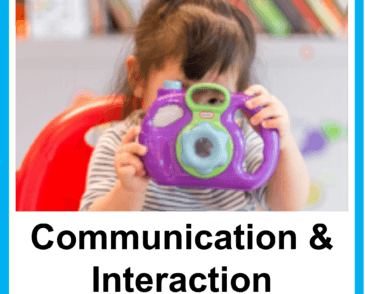

Last Updated - February 5, 2025
Supporting the prerequisites to verbal communication – Early Years – Communication and Interaction
Use VERVE (Video, Endorse, Respect, Vitalise, Eyes) techniques VERVE Child Interaction Blog – Welcome to support the child’s initiation of interactions. Try and remain silent, carefully watching for the child’s eye gaze before making a vocal comment in response to the child’s gaze towards you.
Use Intensive Interaction approaches e.g. follow the child’s lead in their choice of interaction. Play alongside the child with a similar toy or object. Reduce your words and wait for the child to interact (give eye gaze, touch) with you before giving vocal comment.
Spend time playing in parallel with the child, getting to know their play preferences, pace of learning and communication skills, both non-verbal and verbal. Help the child feel comfortable with your presence as a play partner.
Use the Engagement Model to support you with your observations of the child’s play. It is a dynamic assessment and planning tool for adults to consider what is really engaging our children in the play environment and support provision that matches their needs. The Profile and Scale Guidance, templates and worked examples can be found on the Torbay SEN Early Years Resources web page The Engagement Model – Family Hub (torbayfamilyhub.org.uk). Also, guidance and research information can be found on The engagement model – GOV.UK (www.gov.uk)
Engage the child in ‘people play’ activities such as repetitive rhymes and songs (Row-Row and Round and Round the Garden). These sorts of games lend themselves well to the child learning to listen and anticipate actions such as tickling or vocal play. Pause before the climax of the game and wait for the child’s response e.g. pausing before blowing bubbles, pausing before screaming in response to ‘Crocodile’ in Row-Row.
Specifically play simple turn taking games that do not ask for verbal responses from the child directly, but simply help the child learn the back-and-forth style of interaction e.g. making noises with musical instruments in turn, posting balls down a ball run in turn, pressing buttons on a pop up toy in turn, chasing and tickling games, rhymes and song.
Specifically focus on stretching the child’s attention skills while engaging in short adult-led activities such as a ‘Wow Box’ that the child can explore alongside you, or a ‘Sensory Bag’ together. Discovery Treasure Box or Wow Box activity Wow-Box-1.pdf (torbayfamilyhub.org.uk)
Introduce the Bucket Full of Surprises from the Attention Autism programme once the child is secure with exploratory play and can wait for short bursts of time in a back-and-forth game with an adult Attention Autism Programme Gina Davies.
Building attention skills in children: THE BUCKET! – YouTube
Encourage the child to learn to listen and attend during short age-appropriate games using the activity ideas in the following resource Helping Very Young Children to Listen : Flinders, Andrina: Amazon.co.uk: Books
Helping Very Young Children to Listen by Andrina Flinders – this resource provides a range of simple activities for 2 year olds to promote listening skills using a tiger soft toy as the key focus. A great lead-in to Early Talk Boost.
Use Intensive Interaction approaches e.g. follow the child’s lead in their choice of interaction. Play alongside the child with a similar toy or object. Reduce your words and wait for the child to interact (give eye gaze, touch) with you before giving vocal comment.
Spend time playing in parallel with the child, getting to know their play preferences, pace of learning and communication skills, both non-verbal and verbal. Help the child feel comfortable with your presence as a play partner.
Language Builders for Complex Needs – Elklan Language Builders series | Elklan Training Ltd This resource looks specifically at engagement and communication skills with the preverbal child.
View and/or download the Torbay Early Years Toolkit here: Torbay Early Years Graduated Approach Toolkit – Family Hub
